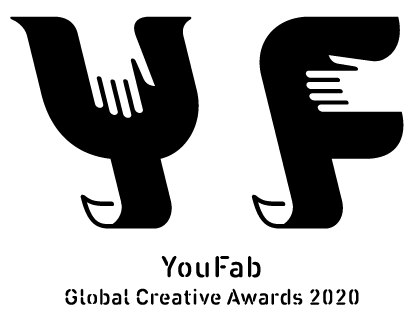-
作品タイトル(日本語)
Instant Flower
-
作品タイトル(英語)
Instant Flower
-
制作物のコンセプトを記載してください。
本作品は、インスタント・ヌードルによる「インスタント性」、つまりお湯を触媒とする「コンタクトレス」な造形の可能性の提案である。
デジタルファブリケーションは、デジタル空間におけるモデルをフィジカルにすることを可能とした。その結果、デジタル空間のみならず、論理的には世界中どこでもフィジカルなモデルの複製を可能としたが、実際はアウトプットの環境により、「差異」を含んでいる。
デジタル技術のものづくりでは、パラメトリックなバリエーションや再現性にその価値があると思われるが、制作物に含まれてしまう「差異」に着目したい。なぜなら、「差異」を認めそこに新たな価値や美しさを認めることに、「リアルな体験」を設計・デザインするためのヒントが隠されている。
この作品では、デジタル技術を用いた制作過程の最後にお湯を触媒とした造形手法を取り入れている。ここでの設計は、出力する際の幾何パターンと断面のみである。3Dプリンターにより出力された平面パターンは、お湯に浸すことで立体へと立ち上がる。
最終的な造形は、人の手を離れ、水中という「コンタクトレス」な環境に委ねることにより、力の拮抗として現れる。「コンタクトレス」な技法から生まれるその造形は、花弁のような自然の造形物に類似している。
デジタル技術のものづくりの未来では、「再現性」だけでなく、差異を含んだ「唯一性」の獲得も求められるだろう。驚きとともに現れる造形に、「景色」としての美学を見出しうるか、そのようなアクティブな姿勢にこそ、未来のものづくりにおける「フィジカリティ」が含まれるのではないだろうか。 -
制作物のコンセプトを記載してください。(英語)
This work is a proposal of the "instant nature" of instant noodles, that is, the possibility of "contactless" modeling using hot water as a catalys.
Digital fabrication has made it possible to turn the model in digital space into the physical.
As a result, it is logically possible to replicate physical models not only in digital space, but also anywhere in the world. However, in practice, it contains "differences" depending on the environment of the output.
In the creation of digital technology, parametric variation and reproducibility seem to have value, but I would like to focus on the "difference" that is included in the product. This is because a hint for designing "real experiences" is hidden in recognizing the new value and beauty contained in the differences.
In this work, at the end of the production process using digital technology, I have incorporated a modeling technique that uses hot water as a catalyst.
The only designs here are the geometric patterns and cross-sections that are output by the 3D printer. The planer pattern output by a 3D printer rises into a three-dimensional form when dipped into hot water.
The flat pattern output by the 3D printer rises into a three-dimensional shape.
The final form emerges as an antagonism of forces by leaving the human hand and leaving it to the hot water as a "contactless" environment.
The shapes created by the "contactless" technique are similar to natural objects such as flower petals.
In the future of manufacturing with digital technology, we will be required to obtain not only "reproducibility" but also "uniqueness" including the difference.
I believe that the physicality of the future of manufacturing will be found in such an active attitude of finding aesthetics as a "scenery" in the forms that emerge with surprise. -
作品の素材・仕様
本作品は、熱可塑性不織布と3Dプリンターの樹脂を材料とする。
そのサイズは、スケーラブルであるが3Dプリンターの出力サイズに依存する。
熱可塑性不織布に、3Dプリンターを用いて直接フレームとなる幾何パターン出力する。出力されたものを切り離しお湯に浸すと、不織布が持つ面内方向に収縮するエネルギーが解き放たれ、フレームと布の収縮する力が拮抗する。それは、シャボン玉のように極小曲面を形成しようとすることで平面から立体へと自己組成をなす。この原理を展開することにより、幾何的なパターンによる平面から有機的な立体造形が可能となる。 -
作品の素材・仕様(英語)
This work is made of thermoplastic nonwoven fabric and 3D printer resin.
Its size is scalable but dependent on the output size of the 3D printer.
A 3D printer is used to print out geometric patterns that form a frame directly onto the thermoplastic nonwoven fabric. When the output is cut off and dipped into hot water, the shrinking energy of the nonwoven fabric is released, and the shrinking force of the frame and the fabric are antagonized.It rises from a flat surface to a three-dimensional one by attempting to form a minimal surface, like a soap bubble.
By developing this principle, it becomes possible to create an organic three-dimensional form from a plane with a geometric pattern. -
作品のリファレンスURL
-
作品の映像URL
https://youtu.be/QPnYzbhugNE
-
公式サイト、もしくはSNSのURL
https://www.instagram.com/ryohey.akita/
-
プロフィール情報
秋田亮平建築設計事務所 主宰
東京藝術大学美術学部建築科 教育研究助手 -
参加メンバー
-
居住国
日本
- 117
Instant Flower
デジタル技術を用いながらも、お湯を媒介とすることで、自然な造形を提案する作品です。


